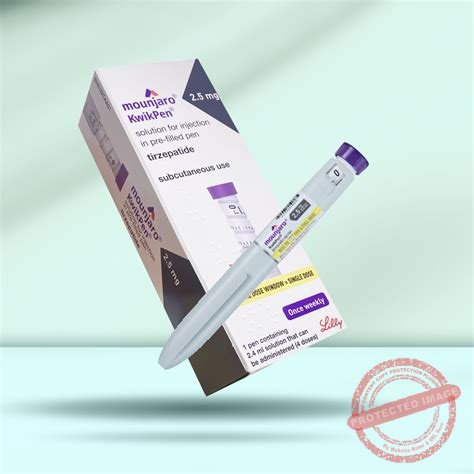

Mounjaro For Sale
$225.00
Mounjaro For Sale: Your Guide to Buying Tirzepatide Online, Costs, and Eligibility

Introduction
Finding it tough to get a Mounjaro prescription for effective weight management or type 2 diabetes control? Mounjaro, featuring the active ingredient Tirzepatide, works by targeting both GLP-1 and GIP receptors. This dual action helps regulate blood sugar and curb appetite, potentially leading to significant weight loss of up to 22.5% over 72 weeks. This guide will walk you through what Mounjaro is, how it functions, who qualifies, how to get a prescription online, recommended dosing and administration, cost details and savings opportunities, potential side effects and how to manage them, comparisons with Wegovy and Ozempic, and a summary of key points before you buy online. Each section is packed with practical advice and clear steps to help you access and use Mounjaro safely and affordably.
What Is Mounjaro and How Does Tirzepatide Work for Weight Loss and Diabetes?
Mounjaro is a once-weekly injectable medication containing Tirzepatide. As a dual GLP-1 and GIP agonist, it mimics natural incretin hormones to enhance insulin secretion and reduce feelings of hunger. By activating both receptor types, it improves blood sugar control and speeds up the feeling of fullness, supporting substantial weight loss when combined with lifestyle changes. Understanding its mechanism of action will help you assess its clinical benefits and make informed decisions about incorporating it into your treatment plan.
What Is Tirzepatide and Its Role as a Dual GLP-1 and GIP Agonist?
Tirzepatide is a peptide composed of 39 amino acids that simultaneously activates GLP-1 and GIP receptors, optimizing metabolic regulation. Activation of the GLP-1 receptor increases insulin release and slows down stomach emptying, while GIP receptor activation aids in fat metabolism and improves insulin sensitivity. These combined effects lead to more stable blood sugar levels and reduced appetite, setting the stage for effective long-term weight and glucose management.
Tirzepatide: A Dual GIP and GLP-1 Receptor Agonist for Type 2 Diabetes Mellitus and Obesity
Tirzepatide (LY3298176) is a dual GIP and GLP-1 receptor agonist currently under development for the treatment of type 2 diabetes mellitus (T2DM), obesity, and nonalcoholic steatohepatitis. Early-phase trials in T2DM patients suggest that tirzepatide improves clinical outcomes more effectively than a selective GLP-1 receptor agonist. Consequently, we hypothesized that tirzepatide’s integrated potency and signaling properties confer a unique pharmacological profile optimized for enhancing comprehensive metabolic control. This study establishes a methodology for calculating receptor occupancy at clinically efficacious doses of the drug. The analysis reveals a higher degree of engagement of tirzepatide with the GIP receptor compared to the GLP-1 receptor, supporting an imbalanced mechanism of action. Pharmacologically, signaling studies demonstrate that tirzepatide replicates the actions of endogenous GIP at the GIP receptor but exhibits bias at the GLP-1 receptor, favoring cAMP generation over β-arrestin recruitment.
Tirzepatide is an imbalanced and biased dual GIP and GLP-1 receptor agonist, FS Willard, 2020
How Does Mounjaro Help Manage Type 2 Diabetes and Obesity?
Mounjaro’s dual incretin action enhances the responsiveness of pancreatic beta-cells and reduces glucagon release, leading to sustained reductions in HbA1c levels by up to 2.5 percentage points. For obesity, it amplifies satiety signals to the hypothalamus, helping to reduce calorie intake by as much as 30%. This comprehensive approach addresses both high blood sugar and excess body fat, making it a suitable option for individuals with type 2 diabetes and related weight concerns.
Tirzepatide: A Novel Dual GIP/GLP-1 Receptor Agonist for Cardiometabolic Health
Incretin hormones are peptides released from the intestine in response to nutrient presence in its lumen. The primary incretins are glucagon-like peptide-1 (GLP-1) and glucose-dependent insulinotropic polypeptide (GIP). GLP-1 stimulates insulin secretion, inhibits glucagon secretion from pancreatic α-cells, and also exerts extrapancreatic effects such as slowing gastric emptying, which enhances satiety. GIP is the principal incretin hormone in healthy individuals, responsible for most incretin effects; however, the insulin response following GIP secretion is significantly diminished in type 2 diabetes mellitus (T2DM). Consequently, GIP was historically considered an unappealing therapeutic target for T2DM. This perspective has evolved in recent years, as it has been reported that GIP resistance can be reversed and its efficacy restored by improving glycemic control. This finding facilitated the development of GIP receptor agonist-based therapy for T2DM, alongside the exploration of a combined GLP-1/GIP receptor agonist. Within this context, the novel dual GIP and GLP-1 receptor agonist tirzepatide appears to be more than just a new antidiabetic medication. Administered as a weekly subcutaneous injection, it is a multifaceted pharmacological agent capable of significantly reducing glucose levels, improving insulin sensitivity, promoting weight loss, and favorably modifying dyslipidemia by improving the lipid profile. Tirzepatide and other dual GLP-1/GIP receptor agonists that may be developed in the future represent a promising advancement for the management of various cardiometabolic conditions. While it is premature to be overly optimistic, as long-term effects and potential cardiovascular benefits require further determination, we are currently presented with a novel and highly attractive therapeutic option.
The dual glucose-dependent insulinotropic polypeptide (GIP) and glucagon-like peptide-1 (GLP-1) receptor agonist tirzepatide: a novel cardiometabolic therapeutic …, EZ Fisman, 2021
What Are the Benefits of Using Mounjaro for Weight Loss?
When used alongside diet and exercise, Mounjaro can offer patients:
- Significant Fat Reduction – Patients can experience an average body weight loss of 20.9% within 36 weeks.
- Improved Metabolic Markers – Benefits include lower blood pressure and cholesterol levels.
- Enhanced Fullness – Delayed stomach emptying leads to reduced calorie intake.
- Cardiovascular Support – Potential reduction in risk factors associated with heart disease.
These wide-ranging benefits contribute to overall health improvements beyond just weight loss, supporting long-term maintenance strategies.
How Can You Get a Mounjaro Prescription Online or Through the NHS?

To get a Mounjaro prescription, you’ll need a medical evaluation to confirm your type 2 diabetes status or obesity (with a BMI of 30 kg/m² or higher, or 27 kg/m² with related health conditions). Both online doctor services and NHS GPs follow similar eligibility criteria, but the consultation process and wait times can differ. Knowing these pathways can help you access the medication more quickly or cost-effectively, depending on your location and insurance coverage.
What Are the Eligibility Criteria for Mounjaro Prescription?
To be eligible for a Mounjaro prescription, you must meet the following criteria:
- Have a confirmed diagnosis of type 2 diabetes or clinically significant obesity (meeting specific BMI requirements).
- Show that initial treatments for blood sugar or weight management have not been sufficiently effective.
- Not have any contraindications, such as a personal or family history of medullary thyroid carcinoma.
Meeting these conditions ensures a safe and appropriate start to your Tirzepatide therapy.
How Does the Online Consultation Process for Mounjaro Work?
The online consultation process begins with you filling out a medical questionnaire detailing your weight history, blood sugar readings, and any existing health conditions. A licensed healthcare provider will then review your information, discuss potential risks and appropriate dosages, and issue a prescription if you are deemed a suitable candidate. Once approved, your prescription can be sent directly to partner pharmacies for convenient home delivery, simplifying the journey from assessment to starting treatment.
What Is the Difference Between NHS and Private Mounjaro Prescriptions?
NHS prescriptions in the UK have specific eligibility requirements, often tied to BMI or HbA1c levels, and may involve longer waiting times with your GP, but the medication is typically subsidized. Private prescriptions, often obtained through online clinics, offer faster access and potentially broader eligibility criteria, but you will bear the full cost of the medication. Deciding between these options often comes down to balancing your need for speed against your budget.
Can You Buy Mounjaro Without Diabetes for Weight Loss?
Yes, individuals who do not have type 2 diabetes but are dealing with obesity and meet the relevant BMI criteria can obtain Mounjaro for weight management. Private clinics often assess your weight history and any related health risks to authorize Tirzepatide specifically for chronic weight management under medical supervision.
What Is the Recommended Mounjaro Dosage and How Should It Be Administered?
Mounjaro treatment typically starts at a dose of 2.5 mg once weekly. This dose is gradually increased in 2.5 mg increments every four weeks, potentially reaching a maintenance dose between 5 mg and 15 mg. This step-by-step titration helps minimize gastrointestinal side effects and improve tolerability. Following the correct dosing and administration guidelines is crucial for both effectiveness and safety.
What Is the Starting Dose and How Does Dosage Titration Work?
The initial dose of 2.5 mg per week allows your body to adjust to the incretin signaling. Every four weeks, the dose is increased by 2.5 mg, with your tolerance and blood sugar response being monitored. This process continues until you reach your personalized maintenance dose. This structured titration approach helps reduce common side effects like nausea while ensuring you achieve the desired metabolic benefits through gradual receptor activation.
How Do You Inject Mounjaro Using the KwikPen?
To inject Mounjaro using the KwikPen: first, check the pre-filled pen to ensure the liquid is clear and the correct dose is displayed. Clean the chosen injection site—your abdomen, thigh, or upper arm—with an alcohol swab. Gently pinch the skin, insert the needle at a 90° angle, and press the dose button. Continue holding the button until the dose counter shows zero. Keep the needle in place for at least five seconds to ensure the full dose is delivered before removing it.
How Should Mounjaro Be Stored and Handled Safely?
Store Mounjaro pens in the refrigerator between 2°C and 8°C until you use them for the first time; do not freeze. Once you start using a pen, you can store it at room temperature (up to 25°C) for up to 21 days. Protect the pens from direct sunlight and avoid exposing them to temperatures above 30°C. Always dispose of used needles safely in an approved sharps container to prevent accidental injury.
How Much Does Mounjaro Cost and What Savings Programs Are Available?
The list price for Mounjaro varies by location and dosage strength. In the US, it can be around $1,060 per month, while in the UK, it might range from £149 to £195 per month. Various savings options, such as manufacturer coupons and insurance co-pay assistance, can significantly lower your out-of-pocket expenses if you qualify. Understanding these programs can make the medication more affordable.
Please note that prices can differ based on the specific dosage and the provider you use.
| Region | Monthly List Price | Savings Option |
|---|---|---|
| United States | $1,060 for four pens | Manufacturer savings card can reduce cost to $25–$463 |
| United Kingdom | £149–£195 per month | NHS subsidy available for eligible patients |
What Is the Price of Mounjaro Without Insurance in the US and UK?
If you don’t have insurance in the US, a month’s supply of four pens typically costs about $1,060. In the UK, private clinics usually charge between £149 and £195 per month. These figures represent the standard prices before any applicable savings cards or subsidies are applied, highlighting the importance of exploring available financial support.
Tirzepatide Cost-Effectiveness for Weight Loss in the UK: SURMOUNT-1 Study Insights
Tirzepatide, an anti-obesity medication, demonstrated significant weight loss efficacy in the SURMOUNT-1 randomized controlled trial. This analysis evaluates the cost-efficiency of tirzepatide in the UK by linking clinical outcomes to drug acquisition costs.
Data from SURMOUNT-1 (2539 participants across global sites) were used to assess tirzepatide’s (5, 10, and 15 mg) impact on weight reduction over 72 weeks (72W), with a focus on drug acquisition costs and cost/weight loss outcome. Cost needed to treat and cost-to-target analyses were performed to determine the economic value of achieving specific weight loss goals and improvements in body mass index (BMI).
Tirzepatide demonstrated significant weight loss, with greater reductions at higher doses. Cost/kilogram of weight loss at 72W was £102.86, £85.41, and £89.24 for 5, 10, and 15 mg, respectively. Average per-patient costs at 72W for 5% weight loss were £1852, £1971, and £2186 (5, 10, and 15 mg, respectively; average 28-day costs: £102.90, £109.52, and £121.47). Average per-patient costs for 10% weight loss were £2258, £2209, and £2338 (28-day costs: £125.43, £122.69, and £129.88). The 15 mg dose was the most cost-efficient for achieving higher weight loss targets (15% and 20%).
In the SURMOUNT-1 study, tirzepatide was cost-efficient in the UK for weight management, demonstrating favourable economic outcomes relative to its efficacy in reducing body weight and improving BMI. It provided additional health benefits, including reduced risks for type 2 diabetes and cardiovascular events and improved mental health. Tirzepatide contributed to cost savings and improved efficiency within the healthcare system by decreasing the burden of obesity-related conditions, thus enhancing overall healthcare resource allocation. These findings support its inclusion in clinical practice guidelines and healthcare formularies. Further research is needed to explore real-world adherence, patient-centred outcomes, and the
Analysis of Tirzepatide Acquisition Costs and Weight Reduction Outcomes in the United Kingdom: Insights from the SURMOUNT-1 Study, 2024
How Does the Eli Lilly Mounjaro Savings Card Reduce Costs?
The manufacturer’s savings card can reduce co-pays to as little as $25 for patients with commercial insurance, offering a maximum discount of $463 for those who are uninsured. The benefits of this card are valid until December 31, 2025, so enrolling promptly can help you maximize your savings whether you are starting or continuing Mounjaro therapy.
What Insurance Coverage Options and Patient Assistance Programs Exist?
Many commercial insurance plans cover Tirzepatide, often under specialty drug categories, which may require prior authorization or step therapy. Patient assistance programs are available to provide medication at no cost or a reduced cost for individuals who meet specific income requirements. Additionally, co-pay assistance programs can help offset high out-of-pocket expenses for insured patients.
How Do Mounjaro Prices Compare Between the UK and US Markets?
When comparing list prices, the US cost for Mounjaro is nearly double the private cost in the UK. However, the savings card available in the US can significantly lower co-pays for eligible patients. In the UK, NHS prescriptions can further reduce costs for those who qualify, making regional healthcare policies a significant factor in the overall affordability of the medication.
What Are the Common and Serious Side Effects of Mounjaro and How Can They Be Managed?

As Mounjaro enhances incretin effects, you might experience temporary gastrointestinal issues like nausea, diarrhea, or constipation. These symptoms usually lessen as your dose is adjusted. More serious potential risks include pancreatitis and gallbladder problems, so it’s important to be aware of severe abdominal pain or jaundice. Managing side effects proactively is key to staying on track with your treatment safely and effectively.
What Are the Most Common Side Effects Like Nausea and Diarrhea?
Common side effects are often related to the medication’s effect on slowing stomach emptying and increasing feelings of fullness:
- Nausea – Affects up to 20% of users, typically mild and temporary.
- Diarrhea/Constipation – Experienced by 10–15% of patients; can often be managed with dietary changes and adequate hydration.
- Vomiting – Less common, and often reduced by increasing the dose slowly.
Taking smaller, more frequent meals and gradually increasing your dose can help alleviate these symptoms, allowing you to continue your treatment without interruption.
What Serious Side Effects Should Patients Watch For?
Although rare, patients should be vigilant for the following serious side effects:
- Pancreatitis – Characterized by severe upper abdominal pain that may radiate to the back.
- Gallbladder disease – Symptoms can include sudden pain in the upper right abdomen or jaundice.
- Risk of Thyroid C-cell tumors – This medication is not recommended for individuals with a personal or family history of medullary thyroid carcinoma.
If you experience any severe symptoms, seek medical attention immediately.
How Can Patients Manage and Minimize Side Effects During Treatment?
To help manage and reduce adverse effects, patients are advised to:
- Follow your doctor’s guidance for slow dose titration.
- Eat small, low-fat meals to ease digestion.
- Ensure adequate hydration and consume fiber to support regular bowel movements.
These strategies can improve your tolerance to the medication and help you consistently achieve its metabolic benefits.
What Are the Contraindications and Warnings for Mounjaro Use?
Mounjaro should not be used by individuals with a history of medullary thyroid carcinoma, Multiple Endocrine Neoplasia syndrome type 2, or severe gastrointestinal conditions. It is also not recommended during pregnancy or for individuals with type 1 diabetes. Before starting Mounjaro, healthcare providers should assess thyroid function and any risk factors for pancreatitis.
How Does Mounjaro Compare to Other Weight Loss Medications Like Wegovy and Ozempic?
Mounjaro’s dual-agonist mechanism offers more significant weight loss results compared to medications that target only the GLP-1 receptor. However, differences in cost and side effect profiles exist. A comparative analysis can help both patients and healthcare providers choose the most suitable incretin-based treatment based on individual goals, tolerance for side effects, and budget.
Here’s a quick look at key comparative data before we go into more detail:
| Medication | Weekly Dose Equivalent | Average Weight Loss | Approximate Monthly Cost |
|---|---|---|---|
| Mounjaro | 15 mg | up to 22.5% | $1,060 / £195 |
| Wegovy | 2.4 mg | up to 15% | $1,350 / £200 |
| Ozempic | 2 mg | up to 10% | $900 / £175 |
What Are the Differences Between Mounjaro and Wegovy in Efficacy and Cost?
Mounjaro’s dual-receptor action leads to greater average weight loss (up to 22.5%) compared to Wegovy, which uses semaglutide (a single-receptor agonist) and achieves up to 15% weight loss. Wegovy generally has a higher list price, making Mounjaro potentially more cost-effective, especially when savings programs are utilized. However, individual responses and tolerance can vary.
How Does Mounjaro Compare to Ozempic and Saxenda?
Compared to Ozempic, Mounjaro typically results in more significant appetite suppression and weight reduction due to its additional action on the GIP receptor. Saxenda (liraglutide), taken daily at 3 mg, results in lower average weight loss (5–8%). Therefore, weekly Mounjaro or Wegovy are generally more effective for substantial fat loss, though they require learning injection techniques.
What Other Weight Loss Medications Are Available as Alternatives?
Other options include Orlistat, a lipase inhibitor, and Mysimba (naltrexone/bupropion). Metformin can also be used off-label for modest weight reduction. These non-incretin medications might be suitable for individuals who cannot take GLP-1/GIP agonists or prefer oral treatments, though their impact on weight and metabolism is generally less pronounced.
What Are Frequently Asked Questions About Buying Mounjaro Online and Its Use?
While a detailed Q&A format isn’t ideal here, common patient questions revolve around prescription requirements, safety monitoring, cost comparisons, using Mounjaro off-label for weight loss, and understanding potential side effects. Being informed about these topics will help you have productive conversations with your healthcare provider and choose the best treatment path for you.
How Do I Buy Mounjaro Online with a Prescription?
Once an online medical assessment confirms you meet the eligibility criteria, a clinician will issue a prescription. This prescription is then processed by a licensed pharmacy, and the medication is delivered directly to your home. Delivery times typically range from 3 to 7 days, depending on the provider.
What Are the Eligibility Requirements to Get Mounjaro?
Eligibility is based on having a diagnosed case of type 2 diabetes or obesity (defined by a BMI of 30 or higher, or 27 or higher with related health conditions). You must also not have any conditions that contraindicate its use, and you should have attempted previous therapies for blood sugar or weight management.
How Much Does Mounjaro Cost with and without Insurance?
Without insurance, the estimated monthly cost for Mounjaro is around $1,060 in the US and up to £195 in the UK. For insured patients, co-pays can be as low as $25, or there may be nominal fees with NHS prescriptions if you meet the subsidy criteria.
What Should I Know About Mounjaro Side Effects Before Buying?
Expect temporary gastrointestinal effects such as nausea, diarrhea, and constipation, which usually improve as your dose is adjusted. More serious, though rare, risks include pancreatitis and gallbladder issues, so it’s important to monitor for any severe symptoms.
Can I Use Mounjaro for Weight Loss Without Diabetes?
Yes, individuals without type 2 diabetes who meet the BMI criteria for obesity can be prescribed Mounjaro for chronic weight management by private clinics. This is provided they have explored lifestyle interventions and are under appropriate medical supervision.
Lion’s Mane mushroom supports memory by encouraging the production of Nerve Growth Factor (NGF), which is vital for forming new neural connections. Further exploration into its role in cognitive resilience reveals even more about its neuroprotective benefits.
Only logged in customers who have purchased this product may leave a review.






Reviews
There are no reviews yet.